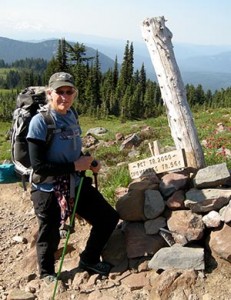
Jane Eisemann, volunteer on the council’s Information and Education Committee, first came to Alaska in 1976 to visit her brother in Kodiak. She immediately fell in love with the state.
“It was a beautiful place,” Eisemann said of her first impression. “My brother lived off the grid, I liked that lifestyle.”
Eisemann returned to California with her mother, but before she left, she secured a job at a local pizza parlor, promising to return for good in two months. The island of Kodiak has now been her home for the last 38 years.
Eisemann began commercial fishing in 1978 for crab, herring, and salmon. That year, she also got a winter job in the small community of Chiniak as a teacher’s assistant. With encouragement from the teacher, Eisemann decided to go back to school for a teaching degree while she continued to fish during the summers.
Before she graduated, the Exxon Valdez ran aground and she ended up working on the cleanup effort. She noted it was a time of upheaval in the community.
“The oil spill just changed everybody’s life,” she said.
The spill also made her reevaluate many aspects of her own life. Not knowing if she’d ever fish again, she turned her focus back on education.
“My first degree is actually in art education, but I never really taught that.”
When she applied to be an art teacher in Kodiak, the administrator noticed her background in commercial fishing and her license to pilot large vessels. He hired her, but not for art. Eisemann took over the fisheries program.
The Kodiak school district owned a boat which Eisemann ran and took students out for Maritime Science and Technology classes. Her experiences during the Exxon Valdez cleanup added to classroom discussions about resource management and safe marine practices.
“The oil spill was firsthand experience of what can go wrong as far as how we handle our natural resources, I’ve been there, done that,” Eisemann said. “I’m not sharing a newspaper article, I was there. I saw it. I smelled the oil.”
“I watched the progression from building the pipeline and all of the issues that people were concerned about, from the time that it opened up, then the complacency set in because we thought it was all working so great,” Eisemann said. “Then we had a big spill.”
“It’s like anything in history, if you talk to someone that experienced that event, it’s more meaningful than reading about it in a book.”
Joining Alyeska’s spill response program
Eisemann recently retired from teaching and now works with a partner, Shelley Eagle, coordinating Kodiak’s fishing vessels that are contracted to Alyeska as part of their oil spill response program. Vessel crews from Kodiak, Valdez, Cordova, Whittier, and other local communities are trained every year on how to respond and clean up an oil spill.
“What I’ve experienced so far is that people are always looking for ways to do things better.”
“I mean, it’s huge, the whole spill response program is huge. I feel like I’m contributing even though I’m getting paid. I feel like it’s honorable.”
“Representatives from each of the fleets from the oil-affected communities get together with Alyeska and talk about how things could be done better from a fishermen’s point of view,” she said. “The logistics of moving boats from point A to point B, what really works on the water, and what really doesn’t work. It’s a nice collaboration between the experts, our fishermen in the region who have local knowledge, and Alyeska, who are charged with making sure that they can clean up that oil if it ever spills again.”
Volunteering for the council
In early 2001, Eisemann joined the council’s board of directors.
“I just fell in love with it,” Eisemann said. “On the council, everybody can find a niche. There is something for everybody, depending on what your interests are. I’m not an oil scientist or a chemical engineer, but we do have people who are and who have a passion for what they know. My passion was education and the environment.”
Eisemann had to resign from the board and the council’s Port Operations and Vessel Traffic System Committee this year after taking the position with Alyeska, but she has stayed involved as a member of the Information and Education Committee.
“My favorite of all the things I’ve done is definitely that committee,” Eisemann said. “That’s right up my dirt road.”
Eisemann has been a member of that committee since it was formed in its current configuration in 2008.
“Thanks to Linda [Robinson, former council staff and current committee volunteer]. She had the vision of what more we could be doing as a council to get the word out there.”
Robinson, Eisemann, and others were concerned that the younger generation was not involved with the council.
“We weren’t connecting them with our mission and how it’s just as relevant today as it was in 1989.”
The group believed that the council needed to reach a broader audience to be successful into the future. Now, the committee spreads the council’s mission through classroom lessons, internships, oral histories of the spill and the council, and social media.
“It just keeps growing. Now I can’t imagine not having that committee. I think it rounds out what the other committees do.”
Eisemann is enthusiastic about the council and the mission to promote the safe transportation of oil.
“I just wanted a way to give back, because you know what? I use oil every single day, and this is my way to try to make that OK.”